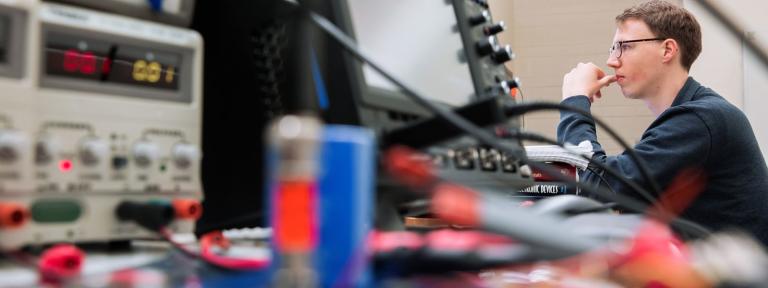
If you are given the choice between building a 1920’s-style pinball machine or a solar panel, of course you choose the pinball machine. Well, you do if you are a class of senior Electrical Engineering students at Kettering University.
Dr. Ken Kaiser’s Senior Electrical Engineering Design class did just that, and the results were, in a word – electrifying!
The assignment was to build from scratch a unique 1920’s-style pinball machine where the ball was partially controlled by electromagnets. In addition to engineering the appropriate slant, ball return system and use of six electromagnets, students were required to use a minimum of 100 nails as bumpers, create a score buzzer, have a removable glass top AND have the machine provide one hour of continuous play without overheating.
The students worked in groups of four to design, implement, document and present a working pinball machine in 10 weeks. “I believe most of the groups really enjoyed themselves, even though it was a lot of hard work,” said Kaiser, professor of Electrical Engineering.
Students Ryan Thelen, of Westphalia, Mich., and Lisa Phare, of Port Huron, Mich., echoed Kaiser’s comments saying that despite choosing pinball over solar panels, “it was a lot harder than we thought it would be.”
They were happy with how their pirate-themed game turned out, despite initial problems getting the electromagnets to work properly. Free license to be creative showed in the details, such as the scull shaped electromagnet controller, treasure box to catch returned balls and ship’s wheel crowning the top of the machine.
Other themes included a golf course, the “Gangster Shoot Out” and a World War II flying ace game complete with plane propeller spinning in the center to send the balls flying. The flying ace game had the electromagnets clearly marked with fire burst stickers. If a player wanted to stop a ball from leaving the play area, they could engage the electromagnets to hold the ball still and then snap it back into play.
Senior Capstone projects are designed to make the students use all of the engineering theory and application they have accumulated at Kettering in one project. The projects are related to students’ field of engineering study, but are generally multi-disciplinary, utilizing what they learn in the classroom and at their co-op assignment.